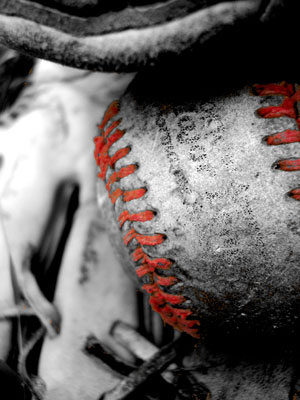All Nonfiction
- Bullying
- Books
- Academic
- Author Interviews
- Celebrity interviews
- College Articles
- College Essays
- Educator of the Year
- Heroes
- Interviews
- Memoir
- Personal Experience
- Sports
- Travel & Culture
All Opinions
- Bullying
- Current Events / Politics
- Discrimination
- Drugs / Alcohol / Smoking
- Entertainment / Celebrities
- Environment
- Love / Relationships
- Movies / Music / TV
- Pop Culture / Trends
- School / College
- Social Issues / Civics
- Spirituality / Religion
- Sports / Hobbies
All Hot Topics
- Bullying
- Community Service
- Environment
- Health
- Letters to the Editor
- Pride & Prejudice
- What Matters
- Back
Summer Guide
- Program Links
- Program Reviews
- Back
College Guide
- College Links
- College Reviews
- College Essays
- College Articles
- Back
In The Dugout : Jackie Robinson
Imagine not being able to play your favorite sport, just because of the color of your skin. Jackie Robinson didn’t have to imagine. For him, it was a hurdle he had to jump over. Jackie Robinson was a professional African-American baseball player who ended over 80 years of baseball segregation in the U.S. Not only was he a pro-baseball player, but a forerunner of the Civil Rights Movement.
Jackie Robinson was born in Cairo, Georgia on January 31, 1919. In 1920, the Robinson’s moved to Pasadena, California. When he was 20 he enrolled in UCLA, and lettered in four sports. Jackie was successful in all of his sports, including track, where he won the NCAA broad jump title in 1940, and in 1941 he played on a semi-professional football team for the Honolulu Bears. But this was just the start for Jackie.
Jackie started his baseball career with the Kansas City Monarchs, an all negro team, in 1945. But before Jackie broke the Major league color barrier in1947, he had some practice with the Montreal Royals (a minor league team for the Brooklyn Dodgers.) While he played for the Royals, Robinson ended the 1946 season with a .349 hitting average.
In 1947 Robinson was scouted by the Boston Red Sox, but even after his tryouts at Fenway, and receiving the most favorable reports out of all three African-Americans that tried out, they showed no interest in putting him on the team. That’s when Tom Greenwade, George Sisler (a former St. Louis Browns player), and Clyde Sukeforth decided to take matters into their own hands. After the signing, Branch Rickey Jr., the Dodgers farm director had a few thoughts on what people might do or say about having an African-American on the team. “Mr.Racine and my father will undoubtedly be severely criticized in some sections of the country where racial predjudice is rampant… Some of them [ballplayers], particularly those who come from the certain sections of the South, will steer away from a club with a Negro player on the roster. Some players with us may even quit…”
Although Robinson played a great season, he suffered from racial abuse. But Robinson never gave up. “Baseball is like a poker game.” Jackie said, “Nobody wants to quit when he’s losing; nobody want you to quit when you’re ahead.” He definitely wasn’t going to quit. His “haters”, as Robinson called them, had given him the “reputation as a black man who never tolerated affronts to his dignity.” That same 1947 season, he was named ‘Rookie of the Year’ led the National league in the stolen bases, and was featured on the cover of Time magazine.
In 1949 Robinson had yet another amazing season, winning the batting title with a screaming .342 average and led the second basemen in double plays. He was officially part of the National League All-Star Team. At the end of what may have been Robinsons best season, he was named the National League’s Most Valuable Player. “…Baseball is a game played by human beings, regardless of color, and I want to have winning baseball.” Burr said after the signing in 1947.
In 1956 Robinson was traded to the New York Giants. That Same year, he retired. He ended his career with a batting average of .311 with the Dodgers, and .333 in All-Star games. Robinson led the Dodgers to six World Series and one World Series Championship within a 10-year span. In 1962 He was inducted into the Baseball Hall of Fame. “Give me five players like Robinson and a pitcher and I’ll beat any nine-man team in baseball.” said Chuck Dressen.
But Robinson’s story goes beyond breaking the barriers of segregated baseball teams. In the 1960’s Robinson became a vocal supporter of Martin Luther King Jr. and the Nat’l Association for the Advancement of Colored People. With this, he served in several campaigns and on the board of directors for the NAACP from 1957 to 1967. He served his community well and a lot of people don’t know that he even established the Jackie Robinson Construction Company in 1970. His Company built houses for families with low income.
On October 24, 1972 Jackie Robinson died of a heart attack at age 53 in Stamford, Connecticut. 65 years ago, one of baseball’s biggest heroes, was signing a contract that made him the first black Major League Baseball player to wear a professional uniform, which made him break the bands of segregated teams. He pushed through the adversity of racism no matter how many times it tried to push him down. He truly is a great role model. Many will remember him as a great influence, just like our former President Ronald Reagan, “He struck a mighty blow for equality, freedom and the American way of life. Jackie Robinson was a good citizen, a great man, and a true American champion.”

Similar Articles
JOIN THE DISCUSSION
This article has 1 comment.